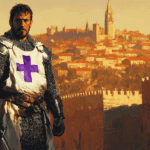
Alfonso VI of León and Castile (1040–1109) is remembered as one of medieval Spain’s most formidable and controversial monarchs. His rise to power was shaped by a bitter and dramatic conflict with his brothers, Sancho II of Castile and García II of Galicia, a struggle that not only determined the fate of the Iberian Christian kingdoms but also set the stage for the Reconquista and the transformation of Spain’s political landscape.
The Seeds of Rivalry: Ferdinand I’s Legacy
The roots of Alfonso’s fraternal conflicts lay in the will of their father, Ferdinand I. Upon his death in 1065, Ferdinand divided his realm among his sons:
- Sancho II, the eldest, received Castile.
- Alfonso VI, the favored middle son, became king of León.
- García II, the youngest, was given Galicia.
This division, intended to maintain peace, instead sowed discord. Sancho, as the eldest, believed he was entitled to all his father’s lands and resented the partition. Alfonso, while favored by his father and mother, was now a rival. García, the youngest, was vulnerable from the start.

The First Clashes: Llantada and the Seven Years’ War
The death of their mother, Queen Sancha, in 1067 marked the beginning of open hostilities. For seven years, the brothers engaged in a series of wars and shifting alliances. The first major confrontation was the Battle of Llantada (1068), a trial by ordeal where Sancho and Alfonso agreed that the victor would claim the other’s kingdom.
On a sweltering July day in 1068, the two small armies faced each other across the river, the stakes were made explicit: both brothers swore that submitting their fates to the judgment of God in what amounted to a judicial duel on a grand scale. Among Sancho’s ranks, the young Rodrigo Díaz de Vivar, later immortalized as El Cid, was present, though his role at this early stage was likely minor, despite later legends that would cast him as Sancho’s standard-bearer.
The battle itself was fierce but brief. The proximity to the border and the absence of a major invasion force suggest a sharp, decisive engagement rather than a prolonged campaign. Sancho’s forces broke through Alfonso’s lines, forcing the Leonese king to flee the field. The victory was clear, but the aftermath was anything but simple. Despite their oath, Alfonso refused to surrender his crown, retreating to León and leaving the matter unsettled.
Yet, in a twist characteristic of medieval politics, the brothers’ enmity did not preclude moments of uneasy cooperation. The occasion for this unlikely pact was the wedding of Sancho II to Alberta, an English noblewoman, on May 26, 1069. Alfonso attended, and amid the festivities, the two elder brothers agreed to join forces against García. Their motives were pragmatic – Galicia was wealthy, strategically placed, and, in their view, too valuable to be left in the hands of their less experienced sibling. The alliance was not born of brotherly love but of mutual advantage: by working together, they could swiftly overwhelm García and divide his lands, each expanding his own domain.

Their plan was set in motion with calculated precision. Sancho, the more martial of the two, led his armies across León, while Alfonso advanced from the south, both converging on Galicia. García, caught off guard by the sudden betrayal, found himself besieged on two fronts. The campaign was swift and merciless. García’s forces, loyal but outmatched, could not withstand the combined might of his brothers. In the chaos, García was forced to flee, seeking refuge in the distant Taifa of Seville, leaving his kingdom to be partitioned by his ambitious siblings.
For Alfonso and Sancho, the victory was a triumph of cunning and opportunism. They divided Galicia between themselves, each claiming the title of king over their newly acquired territories. Yet, the alliance that had brought them success was as brittle as it was brief. The ink on their agreement was barely dry before old suspicions and ambitions resurfaced.
Fratricidal War: The Battle of Golpejera
In January 1072, the brothers met again in battle at Golpejera. Sancho, aided by his formidable now-champion Rodrigo Díaz de Vivar (El Cid), defeated Alfonso. Alfonso was captured and imprisoned, but thanks to the intervention of their sister, Urraca, he was allowed to go into exile in the Muslim taifa of Toledo, under the protection of King al-Mamun.
Alfonso’s exile in Toledo lasted nine months. During this period, he forged crucial alliances and honed his diplomatic skills, which would later prove invaluable.
The Assassination of Sancho II
While Alfonso was in exile, Sancho II consolidated his rule, having eliminated both García and Alfonso as rivals. However, his reign was short. In October 1072, Sancho was assassinated during the siege of Zamora, a city held by their sister Urraca. The circumstances of Sancho’s death remain shrouded in suspicion, with some chroniclers hinting at Alfonso’s involvement, though he always denied complicity.
Upon Sancho’s death, Alfonso returned from Toledo and claimed the thrones of Castile and León, becoming the most powerful Christian monarch in Spain. However, his ascension was not without controversy. Rodrigo Díaz (El Cid), Sancho’s loyal commander, forced Alfonso to publicly swear that he had no part in his brother’s murder – a dramatic episode that would later fuel the legendary enmity between Alfonso and El Cid.

The Fate of García II
With Sancho dead and Alfonso in control, García II’s fate was sealed. Alfonso lured García back from exile under the pretense of reconciliation, only to imprison him for the rest of his life. García died in captivity, his kingdom of Galicia absorbed into Alfonso’s domains.
Now in 1077, Alfonso VI emerged as the sole ruler of León, Castile, and Galicia, and began styling himself “Emperor of all Spain”. His consolidation of power marked a turning point in the history of the Iberian Peninsula. The fratricidal wars, though devastating, had enabled Alfonso to unite the Christian kingdoms and launch a new phase of the Reconquista.
Alfonso’s Later Reign and the Conquest of Toledo
Alfonso’s imperial claim was not merely ceremonial. He quickly asserted authority over neighboring Christian realms, extracting homage from Sancho Ramírez of Aragon for lands north of the Ebro and annexing Navarrese territories after the assassination of King Sancho IV of Navarre in 1076. His court became the political center of Christian Iberia, attracting nobles, clerics, and warriors from across Europe, and his alliances extended through a series of strategic marriages to influential houses in France and beyond.
The heart of Alfonso’s reign, however, lay in his expansion against the Muslim taifas. In the years following 1077, he pressed the rulers of Toledo, Zaragoza, and other taifas for tribute, leveraging the divisions among them. In 1074, he allied with Al-Mamun of Toledo to attack Granada, capturing the fortress of Alcalá la Real. When Al-Mamun died, Alfonso seized the opportunity presented by the instability in Toledo. After a long and calculated siege, Toledo fell to Alfonso on May 25, 1085, a conquest that electrified Christendom and marked the first major Muslim city to be retaken in the Reconquista. Alfonso added “King of Toledo” to his titles, and the city became a new cultural and administrative capital, famous for its libraries and scholars.

The Response to Toledo
The conquest of Toledo, however, provoked a powerful response. The Muslim rulers, threatened by Alfonso’s advance and his demands for tribute, appealed to the Almoravids, a formidable Berber dynasty from North Africa. In 1086, the Almoravid emir Yusuf ibn Tashfin crossed the Strait of Gibraltar with an army, meeting Alfonso at the Battle of Sagrajas (Zallaqah). The Christian forces suffered a devastating defeat, and Alfonso himself narrowly escaped with his life. This battle marked a turning point: the Almoravid threat would haunt the remainder of Alfonso’s reign, forcing him onto the defensive.
Despite the setback, Alfonso’s rule was characterized by resilience and adaptability. He fortified his frontiers, reorganized his armies, and relied increasingly on powerful vassals – none more famous than El Cid. Their relationship was complex: at times, El Cid was a loyal commander; at others, a rebellious exile, carving out his own principality in Valencia. Yet in the face of the Almoravid advance, even El Cid’s independent campaigns ultimately served to shield Alfonso’s eastern flank.
Alfonso’s court was a cosmopolitan center, where Christian, Muslim, and Jewish scholars mingled and translated classical works into Latin and Castilian, laying the groundwork for the later flowering of Spanish learning. He encouraged the use of the Latin liturgy in place of the Mozarabic rite, aligning the Spanish church more closely with Rome and furthering his vision of a united, Christian Spain.

The emperor’s personal life was as eventful as his reign. He married multiple times—among his wives were Agnes of Aquitaine and Constance of Burgundy – securing alliances with French nobility and strengthening his international standing. His children included Urraca, who would succeed him, and Sancho Alfónsez, his designated heir.
The Almoravid Threat
As the Almoravid threat grew, Alfonso’s later years were marked by military struggle and personal loss. He suffered further defeats at Consuegra (1097) and, most disastrously, at Uclés in 1108. At Uclés, Alfonso’s only legitimate son and heir, Sancho Alfónsez, was killed, a blow that left the succession uncertain and the emperor grief-stricken. The loss of Sancho and the mounting pressure from the Almoravids forced Alfonso to abandon Valencia, which had been held by El Cid’s widow after his death.
Yet, even in adversity, Alfonso’s legacy endured. He maintained control of Toledo, the jewel of his conquests, and passed on a greatly expanded realm to his daughter Urraca. His reign had transformed the political landscape of Iberia: the Christian kingdoms were now the dominant force, and the Reconquista had gained an irreversible momentum.
Alfonso VI died in Toledo in the summer of 1109, after more than three decades as emperor. He was buried at the royal monastery of Sahagún, leaving behind a kingdom that was larger, more unified, and far more powerful than the one he had inherited. His vision of a united Spain under Christian rule would not be fully realized for centuries, but his reign marked a decisive step toward that goal. His life, filled with conquest, intrigue, and tragedy, became the stuff of legend, inspiring chronicles, romances, and the enduring memory of a king who dared to call himself emperor of all Spain.
Conclusion
The story of Alfonso VI’s conflicts with his brothers is a tale of ambition, rivalry, and survival. It is a narrative that encapsulates the turbulence of medieval Spain – a land where kinship could be both a bond and a curse, where thrones were won and lost on the battlefield, and where the fate of kingdoms rested on the outcome of fraternal strife. Through cunning, resilience, and perhaps a measure of ruthlessness, Alfonso VI overcame his brothers to become the architect of a new Spanish order, leaving a legacy that would shape the destiny of the Iberian Peninsula for centuries to come.




